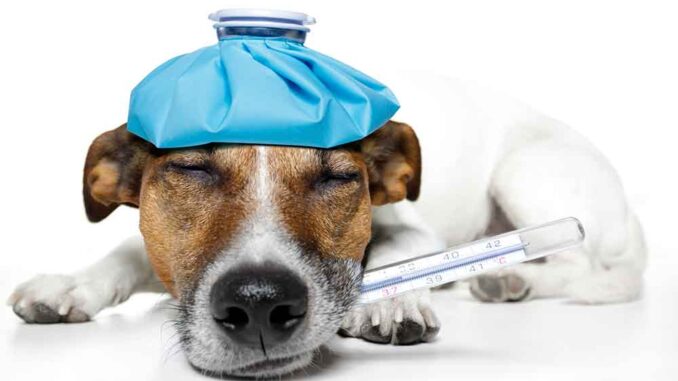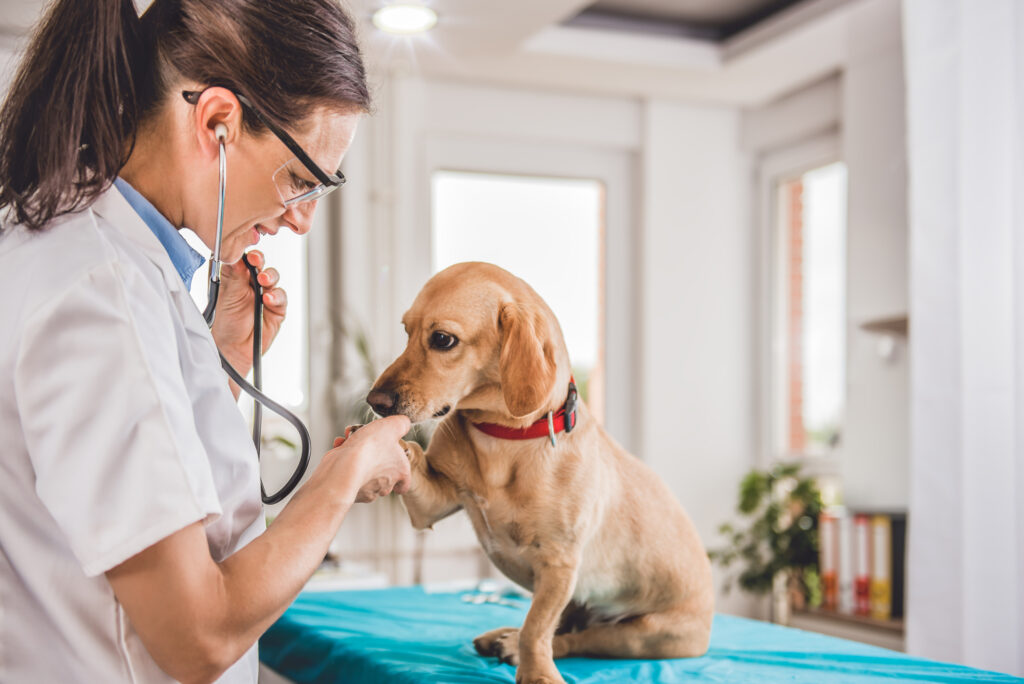
This article was updated on January 9th, 2023
A normal dog’s temperature is from 99.5ºF and 102.5ºF. When you feel your dog, he should feel warm to you. When your dog has a fever, with extreme temperatures, that can indicate your furry friend is sick and needs medical attention. In this article, we will review several easy methods to find out if your dog has a fever. We will also discuss how to help your dog at home, and when to call the vet.
How to tell if your dog has a fever?
Luckily, most fevers in dogs are lower in temperature and easier to treat! Most veterinarians consider anything 103.5º F (39.7º C) degrees or higher to be a fever. Your dog should always feel warm to you, so the most accurate way to assess body temperature is to check it with a thermometer:
1. Rectal thermometers – the most accurate: don’t ever count on your dog holding an oral one safely in his mouth! Here is an example from Amazon:
- COMFORTABLE FOR YOUR PET - The thermometer can be used for pets and is designed to be comfortable with a flexible tip, making it soft and gentle to use.
Always lubricate the thermometer before pushing it gently into your dog’s rectum. Petroleum jelly is ideal but even water can work in a pinch. New digital thermometers let you know when the temperature is ready to read. This is much faster than the old standby of one to three minutes.
2. Ear thermometers: There are also some ear thermometers for pets. These should also give you a fairly rapid digital readout, but they tend to be more expensive (around $35-$45). Surprisingly, many dogs tolerate a rectal thermometer better than an ear reading.
- 【Non-contact pet infrared thermometer】No need to touch the dog, measuring distance is 3-5 cm, measuring position ear, abdomen (need to remove body hair).
But how do you know if your dog has a fever without a thermometer? Let’s review the signs that your dog has a fever.
Signs that your dog has fever
Just like us, a dog with a fever will “feel sick.” You might notice your dog is:
- lethargic,
- not eager to eat his meals,
- not even interested in his favorite toys or going for a walk.
- His ears may be red on the inside and feel warmer than usual.
- A warm dry nose can indicate a fever, though if the ambient temperature is high and the air is dry, his nose will tend to be warm and dry.
A fever is often accompanied by other signs of illness, such as:
- coughing,
- vomiting or diarrhea,
- lameness, or
- being painful somewhere on his body.
Dog temperatures & what they mean
Dr. Ochoa provided the following table to help you understand temperature ranges in dogs and what you should do:
| Temperature | What you should do |
| Under 98ºF | Your pet is cold. You can start slowly warming them with a warm blanket or heating pad. Make sure that you continue to check their temperature as they can quickly get too hot. Any temperature under 95 requires a trip to the vet. |
| 99.5 to 102.5ºF | Your dog’s temperature is normal. No action is required. |
| 102.6 to 103.5ºF | Try home remedies to help cool your dog. If your dog is not showing other signs of illness, monitor the situation at home closely. If your dog’s temperature does not lower within 6 to 12 hours, call your veterinarian. |
| 103.5 to 104.9ºF | Your dog most likely has a fever. This can be due to an infection or overheating. Overheating dogs will often pant a lot. You can try to cool them off slowly with cool water or a fan. Dogs who are not panting and are lethargic often have an infection and will need to see your vet. |
| 105 to 107ºF | Temperatures above 105ºF may cause irreparable brain damage, and veterinarian helps is urgently needed. On the way to the vet, keep the AC on high and keep your dog cool and calm. Most home treatments at this temperature range will not quickly and effectively cool your dog (this could result in detrimental damage to your dog’s internal organs.) |
What can I do at home to help my dog?

In order to treat your dog’s fever, it is important to identify the cause. You can work at making your dog comfortable in the meantime by:
- Offering cool or room-temperature water is helpful. Some dogs will lick ice cubes.
- A fan, especially one blowing over a bowl of ice, can help cool your dog off.
- Putting cold packs in his groin area and on his head.
- Putting cool, wet towels over him may also help. Remember to change these frequently.
If your dog’s temperature was in the serious danger range of 105º F or higher, stop your cooling attempts when the temperature drops to 103º. More cooling could lead to hypothermia or a temperature that is lower than normal.
Can I give my dog over-the-counter medication such as Tylenol or Ibuprofen?
We recommend NOT giving your dog any medication without consulting your veterinarian first. Medications can mask symptoms and make diagnosis more difficult. A fever is secondary to “something,” and you want to treat or eliminate that something, not simply cover up the fever. Additionally, you should not give any human medications (even OTC drugs) unless advised to by your veterinarian.
For how long will my dog be sick with a fever?
Most fevers will resolve quickly once the cause is identified and treatment is started.
Is fever serious for dogs?
A really high fever can be very serious – even deadly. The worst fevers I have dealt with in practice are dogs with status epilepticus—seizures that are prolonged. The intense muscle activity during a seizure raises the body temperature to as high as 105ºF or 107º F. Temperatures that high often cause irreparable brain damage.
What should my dog eat or drink while he has a fever?
Don’t be discouraged if your dog isn’t very hungry while he has the fever. Offer cool, fresh water. Ice cubes made from low sodium bouillon may help to keep him hydrated. If he likes it, cut up watermelon is also a good option. Once the fever breaks, he will be hungry!
What does a vet do if my dog has a fever, and how much will it cost?

Your veterinarian will do a thorough physical examination. That could reveal an abscess, a wound, swollen joints from immune problems, or swollen lymph nodes draining an abscessed area or from a cancer such as lymphoma. Harsh lung sounds and a wheeze could be a sign of cancer, infection, or parasites in the chest.
Costs will vary dramatically depending on the actual cause of the fever and the diagnostics required. If a simple physical exam and antibiotics are all you need, the cost will probably run $150 to $200. Throw in bloodwork and radiographs or an ultrasound, and you are now potentially looking at $800 to $1000.
At your veterinary clinic, diagnostics will almost always include a blood chemistry panel and a complete blood count (CBC). A urinalysis is often helpful. The CBC can give your veterinarian an idea if your dog has a bacterial or viral infection. It can also indicate autoimmune problems where your dog’s own body rejects itself. The blood chemistry panel can tell your veterinarian that your dog has a problem in a certain area of his body such as the liver or kidneys. If indicated, your dog may need radiographs (x-rays) or an ultrasound.
A dog with an elevated temperature due to seizures will be treated immediately to get the seizures under control. That might involve a valium enema or intravenous medications.
What veterinarian treatments are available?
Treatment, especially of a high fever, may require intravenous fluids to maintain hydration in the face of the elevated temperature. Once your veterinarian has an idea of the cause of the fever, treatment will be aimed directly at that. For bacterial infections, the proper antibiotic will be started. This may require an educated guess by your veterinarian until a culture and sensitivity is back. Any abscesses would be opened and drained if at all possible. If antiviral medications are indicated, those will be administered, though there aren’t many available for dogs yet. Only after all the other treatments are completed are antipyretics (medications to lower a fever) generally given.
Related Articles:
- Your Dog Sounds Congested: What Should You Do?
- Dog Breathing Fast or Heavy
Disclaimer: This website's content is not a substitute for veterinary care. Always consult with your veterinarian for healthcare decisions. Read More.




This article is such a valuable resource for pet owners, empowering them to take proactive measures in ensuring their furry companions receive the necessary care and attention they deserve. I’ve learned so much form this article. thanks heaps